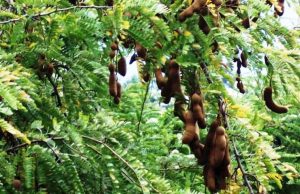It is a multi-purpose tree that has been used for more than 4,000 years as food, human and veterinary medicine, and in art and crafts. The plant is highly valued for its potent effect in relieving pain and irritation.
Acacia senegal is a small, thorny, deciduous tree commonly referred to as arabic gum. The plant is native to the semi-desert and drier regions of sub-Saharan Africa. It is a small tree of about 6m in height, with a greyish bark and strong fibrous inner layers and the leaves are bi-pinnately arranged.
The plant has dense spikes of small yellow flowers which are longer than the leaves. The broad pod fruit contains 5 to 6 seeds. The gum is formed by metamorphosis of the cells of the inner bark exudes spontaneously and hardens on exposure to air forming pale to orange brown colour and is very rich in soluble fibre. The gum is highly valued due to its emulsifying, stabilising, thickening and suspending properties.
Historically, Acacia senegal is a multi-purpose tree that has been used for more than 4,000 years as food, human and veterinary medicine, and in art and crafts. The plant also has valuable use in aromatherapy. In fact, Acacia senegal is one of the species of acacia that was used by the Egyptian and pre-Egyptian healers in medicinal preparations where its soothing properties on inflamed mucus membranes, and its unique ability to treat cough and catarrh were highly exploited.
Each part of the plant – the roots, bark, leaves, flowers, gum, pods and seeds – is used in one way or another in traditional medicinal practice to treat or manage a variety of disease conditions including bleeding, respiratory infections, low blood pressure, bronchitis, leprosy, and typhoid fever among others. The plant is highly valued for its potent effect in relieving pain and irritation. Indeed, this demulcent and emollient property of the gum makes it very useful in traditional medicine for internal treatment of body inflammations and externally to cover inflamed surfaces such as burns, sore nipples, typhoid, nodular leprosy, diabetes, and urinary tract infections.
Acacia senegal gum has also been used to treat bacterial and fungal infections of the skin and mouth as well as to soothe the mucous membranes of the intestines. Apart from its use in African traditional medicine, Acacia senegal gum is also used to treat intestinal disorder among Indian communities. The extract from the plant is given as part of a special diet to provide digestive comfort and improve bowel movement. Furthermore, traditional healers also administer Acacia senegal gum decoction to alleviate the adverse effects of kidney pains and chronic renal failure.
Due to its high astringent effects, Acacia senegal bark and leaves decoction has been used in traditional medicine to treat a number of conditions including bleeding and diarrhoea. The powdered leaves or mixture of the pulverized stem bark with gum is topically applied to treat body injury and to cure wounds. This also stops wounds from bleeding and prevents them being infected by microbial organisms. It is also applied topically to treat skin fungal infections.
Acacia senegal has been used to reduce irritation and inflammation. For instance, the gum has been effectively used to ease stomach and throat discomfort. The decoction made from Acacia senegal gum is also orally administered to treat coughs and sore throats as well as ease or prevent symptoms, including voice loss. In fact, the cough curative effect of Acacia senegal is attributed to the anti-inflammation property of the plant.
The decoctions made from the powdered stems and leaves is taken for treatment and management of dysentery, malaria and diarrhoea. The effectiveness of the decoction is known to be due to its antimicrobial and anti-inflammatory properties.
Nutritionally, freshly harvested gum is directly eaten by people as foodstuff providing a large quantity of dietary fibres and is also extensively used as a food additive in candies, soft drinks as well as chewing gum. In fact, the fibres in the gum are also known to play a vital role in body weight loss management. The seeds are normally harvested, dried and used for human consumption especially during times of food scarcity. In soft drinks and alcoholic drinks, the gum is used either as a flavouring, stabilizer or as a clouding agent.
Apart from the medicinal and nutritional benefits, Acacia senegal is used by local communities in a number of other roles. The mixture of its gum and charcoal dust is used in traditional ink preparation. The dusty and impure gum is usually mixed with animal waste especially cow dung, mud and water and used for painting the walls of newly constructed traditional houses and is known to be very effective in preventing moisture and weevil attacks on the constructed materials.
The plant has also been used for tools and woodwork for centuries. Furthermore, the tree bark, leaves, flowers, and pods are used by farmers as fodder for domestic animals.
The main phytochemical component of Acacia senegal gum is arabin and the calcium salt of the polysaccharide arabic acid. These make Acacia senegal truly a multi-purpose plant that contributes significantly medically, nutritionally, and for foreign exchange earnings for the communities that have engaged in its production, thus providing absolutely valuable social-environmental benefits.
– Richard Komakech






